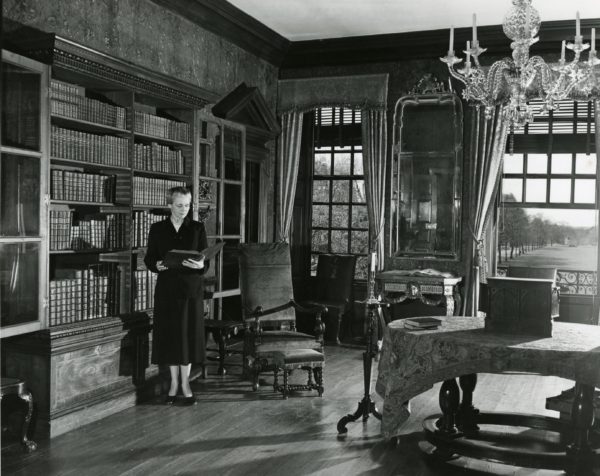
When people think of Colonial Williamsburg, they often think of our Historic Area and the costumed interpreters, historic trades, and vibrant programs found within it. While certainly true, that vision leaves out a critical piece of the puzzle: the John D. Rockefeller Jr. Library. Consisting of the book collection, special collections, and corporate archives, the library provides outside researchers and CW employees with a wealth of information on all facets of life in the 18th century. Indeed, when you see a reenactment on Duke of Gloucester Street, it’s almost a guarantee that every participant has used the library’s holdings to conduct research, and that the program itself is based on its primary and secondary resources.
Today, the library boasts a massive collection that includes 10,000 rare books, 50,000 manuscripts, and 350,000 images. So in honor of Virginia Archives Month, we decided to explore a simple question: what were some of the “firsts” associated with this now large—and constantly growing—collection?
First Archivist:
Lester J. Cappon

Early on, Foundation leadership recognized the value of preserving Colonial Williamsburg’s institutional history. The creation of the Archives Department—now known as Archives & Records—on November 1, 1945 streamlined that preservation. Pictured here is the department’s first director and CW’s first archivist, Lester J. Cappon. Cappon also served as the director of the Omohundro Institute of Early American History and Culture, and was professionally involved with the development of archival theory and practice in the United States.
This photograph of Cappon was taken in his office in 1951 and, interestingly, CW’s current Director of Archives & Records, Carl Childs, still occupies it today. See that wooden tray on Cappon’s desk in the picture? Mr. Childs still uses it, as well.
Today Corporate Archives & Records has 5,000 boxes of permanent records, approximately 6,000 boxes of non-permanent records managed at any given time, around 1,800 rolls of microfilm, and over 1 million digital images.
First Drawing of the Restoration:
Perry, Shaw, & Hepburn, Williamsburg Town Plan (1927)
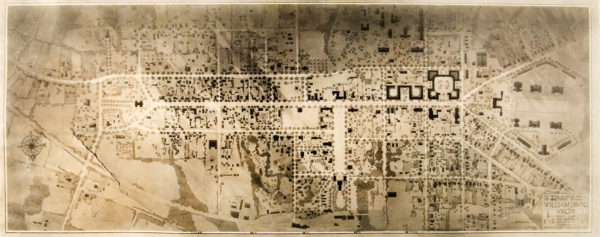
Measured by William G. Perry, drawn by Sammy Macmurtrie, and revised by Andrew H. Hepburn, this was the first drawing made by the Boston architectural firm of Perry, Shaw, and Hepburn for the overall restoration project of Williamsburg. Measuring eight feet in length, it was presented to the restoration’s benefactor, John D. Rockefeller Jr. in New York City in November 1927. Today, the library holds over 50,000 architectural drawings.
One of the First Gifts from John D. Rockefeller Jr.:
Sir Guy Carleton Papers (1936)
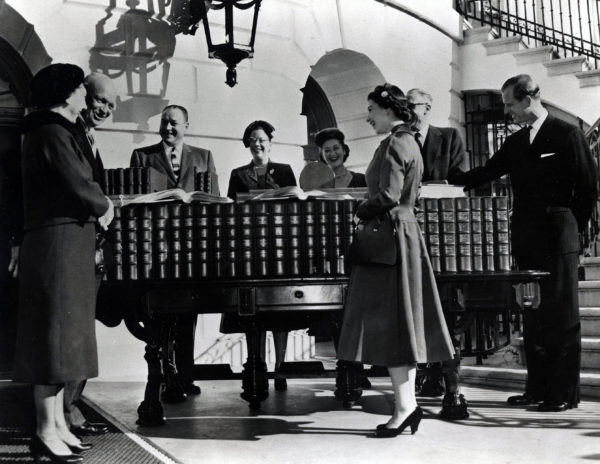
Early Foundation leaders understood how much information would be needed to bring Colonial Williamsburg to life, and John D. Rockefeller Jr. supported them in acquiring the necessary primary and secondary sources. One of the first manuscript gifts that Rockefeller made was the Sir Guy Carleton Papers in 1936. Consisting of over 10,000 documents, the Carleton Papers provide an invaluable look into the actions of several British command headquarters in the American colonies from the outbreak of the Revolution to its conclusion.
In 1957, Colonial Williamsburg decided to return the original papers to the British people, and presented them to Queen Elizabeth II as a gift of the citizens of the United States. The library retained bound Photostats and microfilm of the complete set of papers, and researchers still use those copies today.
First Purchased Imprint:
John Ambercrombie & Thomas Mawe, Every Man His Own Gardener (1782)
John Ambercrombie & Thomas Mawe’s Every Man His Own Gardener was the first eighteenth-century imprint purchased for the Research Library on November 30, 1936. First printed in 1767, this popular gardening book went through more than twenty-five editions. This work consists of a very detailed, month-by-month description of all activities necessary for the maintenance of a garden. It includes an alphabetical listing of kitchen garden plants, fruit trees, ornamental shrubs, perennials and biennial flower plants.
First Rare Book:
Mark Catesby, Natural History of Carolina, Florida, and the Bahama Islands (1771)
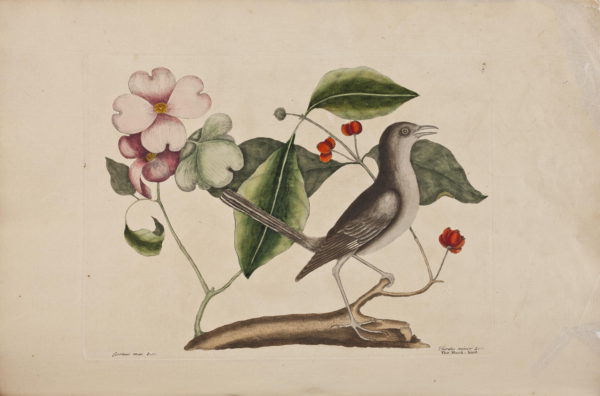
This volume, given by P. Catesby Jones on August 7, 1928, was the first rare book received by Colonial Williamsburg. Mark Catesby’s sister, Elizabeth, lived in Williamsburg in the early eighteenth-century. While visiting her, Catesby explored colonial Virginia and drew those species he thought indigenous to the area. Unable to afford engravers, he himself transformed his watercolors into two hundred plates of birds, reptiles, fish, insects, and mammals. Volume I was originally published in 1731. This illustration of a mock-bird and a dogwood branch is from the third edition.
First Manuscript Acquired as a Gift:
Plat of Bassett Hall (1869)
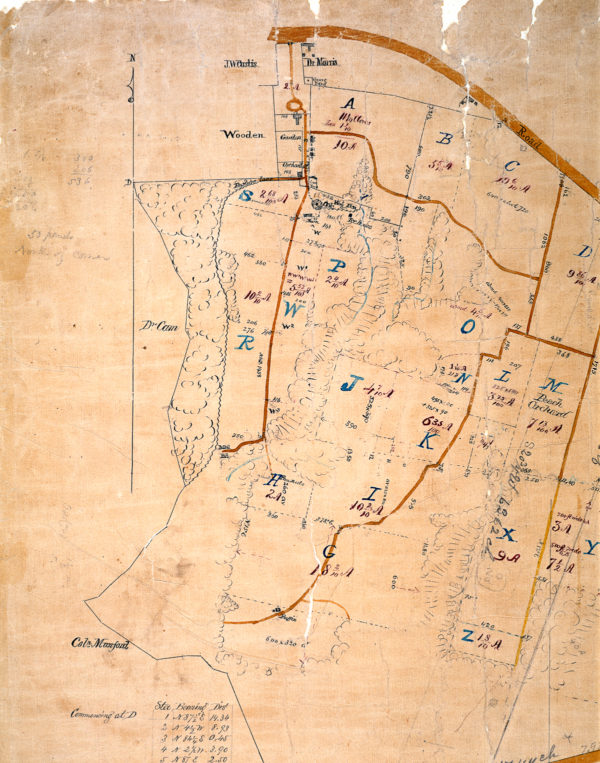
This was the first manuscript acquired as a gift from the occupants of Bassett Hall, Misses Alice and Edith Smith, in 1926. Dating to 1869, this early plat shows the location of the 18th-century house and the Great Oak tree. Mr. Rockefeller and Dr. W.A.R. Goodwin first met to discuss the restoration of Williamsburg under this tree on November 27, 1926. Well over 300 years old, the Great Oak was destroyed in an ice storm in December 1998. Bassett Hall was the home of John D. Rockefeller Jr. and his family when they visited Williamsburg from 1936-1979.
First Photography Collection:
The Clyde Holmes Photography Collection (1933)
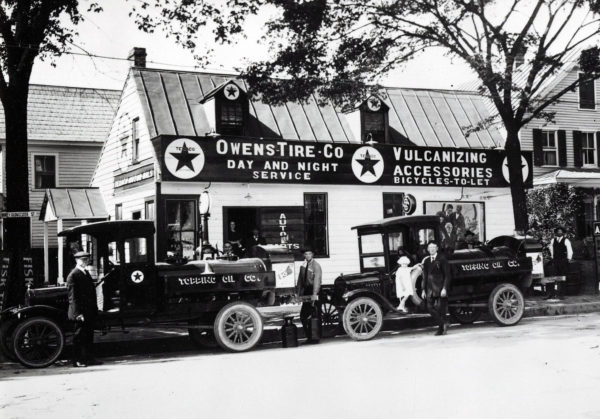
The Clyde Holmes Photography Collection is the first pre-restoration photographic collection acquired by the Foundation. Holmes was a long-time Williamsburg resident and photography enthusiast who worked at the Imperial Theater on Duke of Gloucester Street. Recognizing the value of his photographs for research purposes, Dr. W.A.R. Goodwin purchased Holmes’ collection from his wife in 1933. The business featured in this image from 1928, the Owens Motor Company, is now the site of the Craft House on Merchants Square at the corner of Duke of Gloucester and North Henry Streets.
First Special Collections Transcripts:
William Gooch Official Correspondence (1727-1752)
The William Gooch Official Correspondence was one of the first gifts of a set of manuscript transcripts received on behalf of Colonial Williamsburg. Sir William Gooch served as Lieutenant Governor of Virginia from 1727-1749. Dr. W.A.R. Goodwin accepted the gift of his correspondence from members of the Gooch family in 1934. These typescript letters were presented on behalf of Sir Timothy Gooch, Bart.
First Library Project:
Reconstruction of Lord Botetourt’s Library at the Governor’s Palace

Efforts to reconstruct the library of Lord Botetourt for display in the Governor’s Palace began in the 1930s. The survival of an inventory of the effects of Lord Botetourt, taken at the Governor’s Palace in 1770, allowed Colonial Williamsburg’s first research librarian, Genevieve Yost, to compile a detailed list of the titles housed in the Governor’s Palace during Botetourt’s service as governor. Unfortunately, we have been unable to locate a photo of Ms. Yost, but this image features another member of the Research Department, Ms. Knox, examining a book in the reconstructed library.
First Centralized Library:
Boundary Street Office Building (1985)
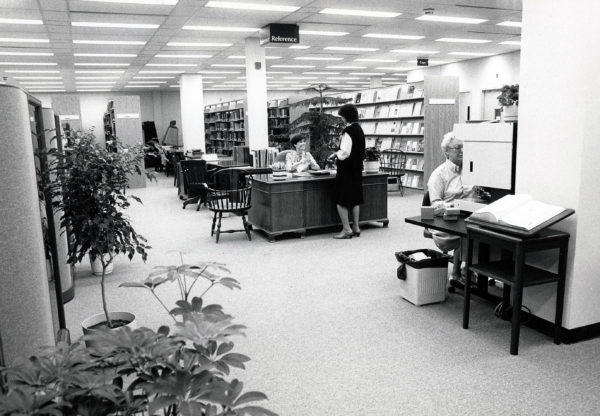
In 1985, Colonial Williamsburg’s first centralized library opened in the Boundary Street Office Building. Prior to this, CW had smaller, division-specific libraries scattered around the Foundation. Each group had developed the library they needed to do their work. Opening this unified library helped simplify management and research.
The John D. Rockefeller Jr. Library Today
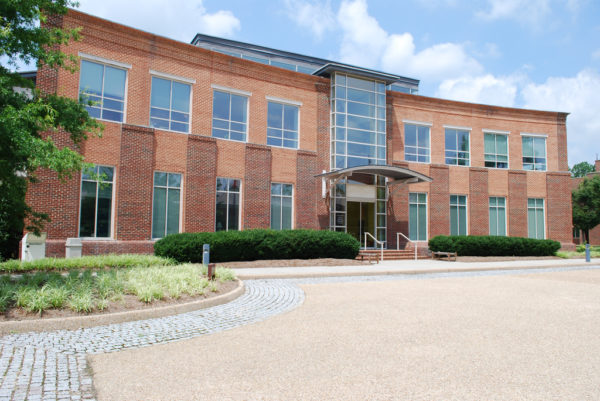
Although the Boundary Street library was a great step forward, it did not take long before the collection exceeded the space. By 1990, a new solution was needed. Once again, the generosity of the Rockefeller family offered the solution. They provided a gift that enabled construction of a new building with the space necessary to provide a centrally administered program of library services for the entire Foundation—aptly named the John D. Rockefeller Jr. Library.
If you haven’t visited the library before, stop by during your next visit! It is open to the public and researchers Monday through Friday, 9:00 a.m. to 5:00 p.m. You’ll not only find an impressive collection, but an equally impressive cadre of librarians and archivists who are carrying the torch lit by their predecessors decades ago.
Special thanks to Visual Resources Librarian Marianne Martin and Associate Archivist Sarah Nerney for their invaluable assistance creating this post.
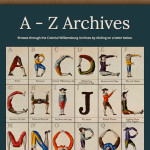
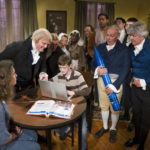
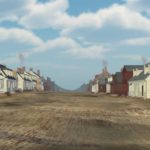
Wonderful article! Would LOVE to see some features on research - esp. costuming, creating appropriate interiors, etc!
Thank you for profiling archives and special collections. An a beginning career archivist/special collections librarian, I can only dream of working in such an amazing library some day! I didn’t make it there on my last visit, I was too busy enjoying the spring weather after a long New England winter, but hopefully I can visit again soon.
The world of the library continues to be an open door. Adored the article; more things to learn about Colonial Williamsburg … an ever-growing wealth of the past.
I highly recommend the Behind the Scene’s Tour at Bruton Heights. After the subject of the day portion (musical instruments, textiles, pottery, architecture and many others) depending on the day, you might head for the John D. Rockefeller Jr. Library. It is a very interesting place. You might see Bill Barker - Thomas Jefferson, Ron Carnegie - George Washington, or many other of the Founding Fathers or interpreters combing the stacks for information. And if you’re lucky enough you might see something special. They have many important documents. You never know what might be out for viewing.